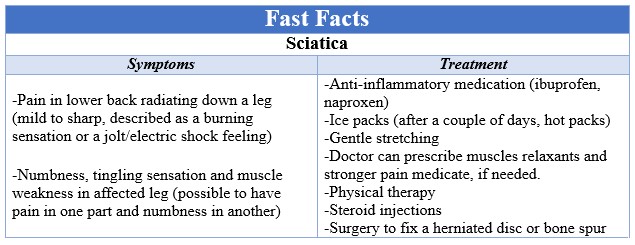Why does your back hurt?
You wake up, get out of bed and all of a sudden you have sharp pain in your lower back that goes through your butt and down one of your legs. Your leg feels numb and has a tingling sensation. When you try to walk, your leg doesn’t seem like it will support you. What is going on? Why is this happening? What can you do to fix it?
 Definition
Definition
Sciatica is when the sciatic nerve in your lower spine gets compressed causing pain and/or numbness. The sciatic nerve branches out from your spine in your lower back and goes through your hips/buttock before further branching down each leg. Usually the compression occurs only on one side at a time, this causes the pain/numbness to be on one side or the other. Compression of the nerve can be from a herniated disc, bone spur on the spine, or a narrowing of the spine (spinal stenosis). The compression causes inflammation and this is what causes the pain/numbness. The pain can be mild to sharp and is often described as a burning sensation or a jolt/electric shock feeling. Numbness, tingling sensation and muscle weakness are common in the leg of the affected side. It is possible to have pain in one part of the leg and numbness in another. Prolonged sitting and coughing/sneezing actually make the symptoms worse.
Treatment
Most often, sciatica can be treated at home. Anti-inflammatory medication (ibuprofen, naproxen) are helpful. Initially, applying ice packs can provide relief and after a couple of days switching to heat is beneficial. This allows the initial inflammation to be limited and then reduced. Gentle stretching is excellent to help loosen up any stiff muscles and tendons that may be contributing to the inflammation. If you are not getting any relief after a couple of days of trying home remedies, you have difficulty controlling your bowels/bladder or the pain started after a traumatic injury, you should see a doctor to be evaluated to rule out any serious conditions. If nothing serious is found, your doctor can prescribe muscles relaxants and stronger pain medication. They will probably recommend that you do some physical therapy to help not only with the healing process but in order to strengthen muscles in your back to correct posture and improve flexibility to reduce the chance of another sciatica flare up. Sometimes, the doctor will need to inject steroids into the area around the involved nerve root to help reduce the pain by suppressing the inflammation. This is only done in severe cases. If you have flare ups frequently and the cause is determined to be a herniated disc or bone spur, your doctor may recommend surgery to fix these.
Prevention
Obviously, having sciatica is not a pleasant experience and can be very limiting in your ability to perform regular activities. There are a few things that you can do to help decrease the chance that you might have a sciatica episode. The most important is to maintain proper posture when you are sitting. This helps to reduce the strain on your muscles in your back. Another key element is to use good body mechanics when you are moving things. This will help diminish the risk of injury to your back that could precipitate a sciatica event. Exercising regularly is crucial to helping maintain flexibility and strengthening muscles in order to lower the likelihood of an injury occurring. Several things can contribute to the possibility of a sciatica incident and they include age, obesity, diabetes or occupation that requires the same repetitive motion or prolonged sitting. By controlling obesity and diabetes, you can reduce your chance of sciatica. Also, taking a look at your work environment to improve it in ways that will help lessen the risk of injury.
Sciatica can come as a surprise, especially the first time you experience it. However, it can be treated and with some minor adjustments to how you sit and/or work habits, it will decrease the possibility of it recurring. If you have any questions about sciatica, please speak with your doctor. If you would like further information, please visit the American Academy of Orthopaedic Surgeons’ page on sciatica at http://orthoinfo.aaos.org/topic.cfm?topic=a00351